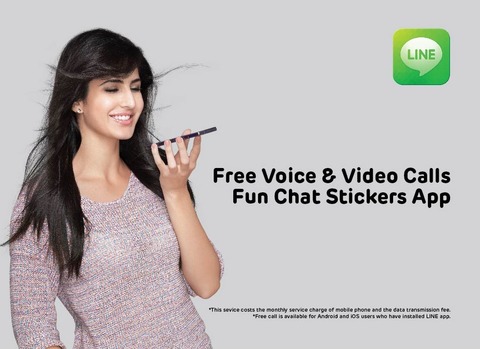Mobile messaging app Line, which has been on a marketing push in India, has added 10 million Indian users to its registered users count in around three months, as it prepares to kick off a Bollywood actress-backed TV ad campaign in the country. Since officially launching in India, Line said voice calls on its service have grown 3,200 %, use of stickers is up 1,800%, and messages have grown by 700% since June 2013.
Line revealed the growth figures in a blog but did not specify how many of these new signups are staying active vs trying and then ditching its app. Monthly actives are a more telling metric for apps but Line does not yet break out MAUs, even though some rival messaging apps do, such as WhatsApp (which now has some 300 million MAUs).
At its last count Line said it had around 250 million registered users. It has also previously confirmed that figure is actually a combined total covering all its iPhone/Android/Windows Phone/BlackBerry/Nokia Asha/feature phone apps. That’s significant because Line requires users to register again if they are using its service on different mobile devices — so it’s likely that registered users figure is being inflated somewhat by duplicate app users, or as people upgrade from feature phones to smartphones, although it’s not possible to say by how much.
Line, which was originally created by NHN Japan (part of South Korea’s NHN Corp), bagged a big following in Japan in 2011 and 2012 before spreading its net wider to target markets outside Asia, including Spain and South America. It’s been steadily adding to its registered users count ever since, as well as extending its feature set (most recently adding video calling and Vine-esque video clips).
But without MAUs it’s hard to say exactly how sticky Line is providing outside its home market of Japan — where it draws the majority of its revenue, and where the proportion of MAUs vs registered users may be as high as 80%.
Add to that, the company has been using some high profile marketing to spur user registrations in a string of markets so the size of its marketing budget is another key consideration when it comes to assessing the overall vitality of its messaging business. Line Corporation doesn’t disclose marketing spend either.
In India, Line appears to be following the same marketing formula it applied in Spain — where it used a high profile TV campaign with local actors Michelle Jenner and Hugo Silva to attempt to adhere its sticker-character-fuelled charm to national affection centres.
Discussing its India strategy, Line notes:
Anticipating the continuing growth of the smartphone market in India, popular Bollywood Actress Katrina Kaif has been brought in as a brand ambassador, and a TV commercial campaign will be launched on October 11, coinciding with the Diwali festival. In a global first for the company, we will be releasing free India-exclusive stickers featuring photographs of Katrina Kaif.
In the blog, Line CEO, Akira Morikawa, goes on to note that Line’s growth rate in India has been more rapid than in any other country it’s launched in to date, “far exceeding” its expectations. “With the help of our marketing partnership with Katrina Kaif, along with other partnerships with entities in India, we are confident that we can easily surpass 20 million users by the end of the year,” he adds.
Line may not have broken out active users yet but it does report its quarterly revenues. Those figures show that it has been able to monetise a core free messaging offering via add-on services such as paid stickers and in-app purchases. Line’s Q2 revenue was $132 million, up from $59 million in its Q1.
The mobile messaging app space is an increasingly crowded and competitive one, with tech giants and startups alike drawn in by the lure of building highly engaged, multi-million-strong user-bases as players like WhatsApp and China’s WeChat have been able to. That competitive crowd makes user acquisition something of an arms race for messaging apps — albeit, an ongoing one, that’s augmented by a parallel social feature-creep marathon, required to keep pace with each other and with evolving comms fashions in order to keep those precious users engaged.
